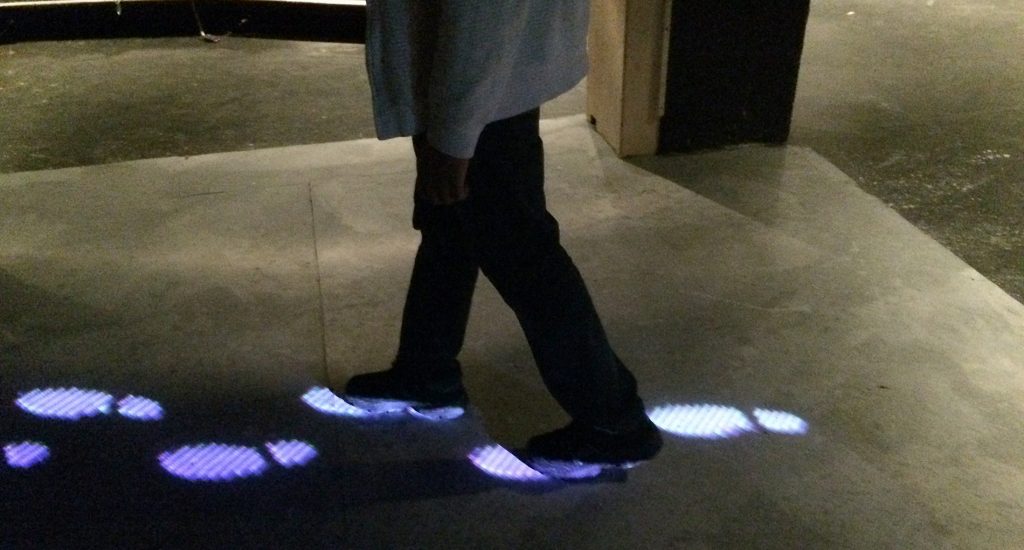
Alison Dobbins, Associate Professor of Integrated Performance Media Design, is at the forefront of a new frontier in theatre – one that integrates digital media, lighting, and theatrical production to provide magical effects for the stage.
A motion graphics artist, Dobbins designs special effects for theatre performances using digital media and state-of-the-art projections.
“You are taking a field that is traditionally in a box, it’s on the computer and will be shown on the screen, and you are putting it on a three-dimensional object,” Dobbins said. “It’s a three-dimensional set that then has to integrate with the lighting design that has to integrate with the actor motion, etc.

“It’s really cutting-edge. There’s no rule book. There’s no formula. It’s almost like being in the initial days when film was being invented, when you just tested it on an audience. Did it work? If they liked it and got the story, then yes, it did. That’s one of the best things about being right here in digital theatre – we’re there again.”
It’s really cutting-edge. There’s no rule book…that’s one of the best things about being right here in digital theatre
ALISON DOBBINS
Dobbins documents and explores new ways of presenting creative activity as a projected performance art, requiring that she work with a number of different disciplines.
“The field I’m in is very interdisciplinary. Any young field is because it’s being built and you don’t build it out of nothing. You build it out of all the fields it is part of,” she said. “To really go far in the field of digital theatre, we need to look at psychology; we need to look at film; we need to look at theatre; we need to look at history; we need to look at art; we need to look at all the pieces that make up digital theatre and all the different ways we could look at accessing this. In that way, we are constantly looking at those new avenues of exploration.”
Dobbins has taught at MSU for the past eight years in the College of Arts & Letters’ Department of Theatre and the College of Communication Arts and Sciences’ Department of Media and Information.
“I came to MSU for the opportunity to combine arts with technology,” she said. “I really wanted to do the art and the creative side of it, not just the technical side. And when this job was offered in the Theatre Department that was combining media and theatre, I jumped at the chance.”
At MSU, Dobbins teaches students how to integrate digital media and design into stage productions. This includes cross-disciplinary learning between majors, collaborating with one another, project managing and mapping, and communication strategies – all while layering in the latest technological advances in stage performances that give audiences a performance like they had never seen.
Students from a wide variety of majors, such as music, media, theatre, and engineering, have enrolled in the courses Dobbins teaches.

“I recruit students from across the University to my classes,” she said. “I find that if you create a classroom that’s interdisciplinary, you create a place for those conversations to happen, where it’s about translating from one discipline to another, talking about the story from totally different angles.
“It’s also not a boxed career anymore and a lot of our students are facing jobs that never existed before, so when you’re talking interdisciplinary, and you’re talking that soft skill of being able to translate things, you’re talking those core humanist and artistic values, that’s one of the keys that students who’ve worked on shows and in my classes, have taken away. Everything is creative, everything is about translating, and so if you are reinforcing that in a class as the underlying principle, students will know how to translate those skills and put it all together.”
Dobbins is the project director and creator of Theatre Engine, an interdisciplinary project focused on exploring audience engagement in dance through the use of mobile applications. She also is a co-principle investigator on Dancing Computer, an interdisciplinary project focused on developing methods to teach dance and computer literacy to elementary school students.

With anything Dobbins does, collaboration is the key.
“I’ve always been a collaborator. I happen to be a teacher, but I’m a collaborator first,” Dobbins said. “Getting a lot of people involved in a project and having them excited by it and receiving something fulfilling out of it is what really feeds me. That’s why I came to theatre in the first place because theatre is one of the foremost versions of collaboration. It brings people together.”


